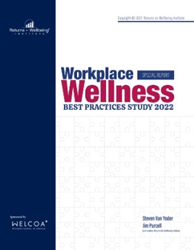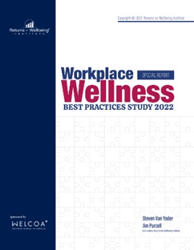
Workplace Wellness: Best Practices Report 2022
“Our research suggests that employee wellness efforts are most successful when they are part of a broader business strategy,” said Steven Van Yoder, Co-Founder of the Returns On Wellbeing Institute.
SAN FRANCISCO (PRWEB)
July 28, 2022
A study of 18 award-winning wellness programs explored how six best practices can help employers achieve better employee outcomes and bottom-line returns. The study was conducted by Returns On Wellbeing Institute (ROWI) and sponsored by the Wellness Council of America (WELCOA). Findings from the study are available in the free, downloadable Workplace Wellness: Best Practices Report 2022.
Through interviews and analysis of 18 award-winning wellness programs, the study explored the extent that companies with reputations for exemplary employee wellness programs, or that had been certified for employee-centric business practices, incorporated these best practices to achieve optimal employee health and wellbeing outcomes and business returns.
Key findings from the study include:
Whole Person Approach. Many wellness programs prioritize physical health by focusing on exercise, reducing body mass index (BMI), and lowering blood pressure. While physical health is important, several research studies show that wellness programs can achieve better outcomes by taking a whole-person approach that addresses other wellbeing aspects that determine total health.
Nearly all participant wellness programs were designed with a whole-person approach that addressed multiple aspects of employee wellness. For example, most participants prioritized mental wellbeing and included mental health education and communication in their wellness programs, unlike a majority of U.S. employers with over 10 employees who do not invest in comprehensive (whole-person) workforce wellness programs.
Prioritize workplace culture. Research shows that organizational cultures can play an important role in supporting employee wellness programs. Among the participants we interviewed, most said employee wellbeing was central to their cultures, and half said culture was a C-suite priority. To ensure employee feedback informs company cultures, most interviewees conducted annual employee wellbeing surveys.
CEO leadership. Executive leadership helps wellness programs achieve their full potential, and leadership commitment is a top success element of effective workplace wellness programs. Over half of the participants said their CEOs spoke about wellbeing in employee communications, participated in company wellbeing events, and shared personal stories about their own wellbeing. A few participants said their C-suite executives participated in mental health communication platforms and talked about their own mental health issues.
Opportunities and recommendations. This study shows why employee wellness is more than a perk. It’s a core business strategy that should be part of every company’s employee value proposition to help attract and retain employees and improve engagement, meet new human capital challenges, achieve better employee outcomes, and deliver meaningful business returns.
This study reveals opportunities for employers everywhere to re-envision their wellness programs by reframing their reason for being. It also suggests that employers must shift from approaching employee wellness as stand-alone, physical-focused programs to strategic initiatives that can help companies become more competitive and profitable.
“Our research into best practices and how companies with exemplary wellness programs apply these best practices provides guidance for employers to better design and implement their workplace wellbeing initiatives,” said Jim Purcell, Co-Founder of Returns On Wellbeing Institute.
“Our research suggests that employee wellness efforts are most successful when they are part of a broader business strategy,” said Steven Van Yoder, Co-Founder of the Returns On Wellbeing Institute. “The research also suggests opportunities for improving wellness programs through planning for and measuring business returns, prioritizing financial wellbeing, and articulating business purposes that inspire employees.”
The free report is available for download at https://returnsonwellbeing.com/best-practices-study-2022/
ABOUT RETURNS ON WELLBEING INSTITUTE
Returns On Wellbeing Institute is a research, analysis, and strategic consulting firm that helps employers design workplace wellbeing initiatives that achieve strategic business outcomes. Our work is powered by ongoing research into best practices in workplace wellness. Our team helps organizations apply evidence-based practices in workplace wellness to help employees achieve optimal wellbeing and help employers achieve measurable business returns. Learn more at returnsonwellbeing.com.
ABOUT WELCOA
For 30+ years, WELCOA has served as the source of information and inspiration to propel the workplace wellness profession forward. For this study, WELCOA provided extensive background data and facilitated interviews with several designated WELCOA Platinum and Gold Well Workplaces ™.”
WELCOA provides a thriving community of wellness enthusiasts, comprehensive training led by the nation’s top experts, and access to an expansive library of effective tools and templates. WELCOA’s mission is to be a transformative force that improves the health and wellbeing of all working people. As a purpose-driven, nonprofit organization, we are squarely and solely focused on generating health and prosperity for our members, their companies, and the places we all call home. Learn more at welcoa.org.
Share article on social media or email:

